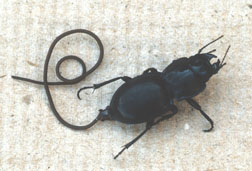Within Nematomorpha there are two orders the Gordiodea and the Nectonematoidea. These two orders are very similar in their ways of life. The biggest similarity is how they effect hosts; both temporarily paralyze their hosts until they are complete in development. Upon exiting the hosts can die prematurely and the nematomorphs go one to live and reproduce. Surprisingly, this isn’t the only species to do such work. In the figure below you can see that Nematomoprha and Nematoda are closely related. But how close can they really be?
(2)
According to Wright, J.; the phylum Nematomorpha contains two orders; Nectonematoidea and Gordiodea, both of which are parasitic as larvae and free living as adults. These two orders also have very similar habitats that include marine/fresh water, coast shore, and damp/moist terrestrial areas.(1)
However, the two orders dp have different blastocoeloms. Nectonematoidea have a spacious blastocoelom and Gordiodea have one filled with mesenchyme. (1) The two also inhabit two different types of organisms as parasitic larvae. Gordiodea inhabit terrestrial organisms and make their way back to the water where Nectonematoidea inhabit aquatic animals and typically remain in the water.
As shown above and stated before, the closest taxa to Nematomorpha are the Nematodes which share a node making them sister taxa. Larvae from both are ingested by the host organism in which they exhibit parasitic lifestyles. The feeding of the larvae on the hosts causes premature death in hosts from both phylum, from here the larvae molts and becomes adults to escape the host and become free living adults. Moist conditions/environments are typical in both Nematomorphs and Nematodes.
In a study conducted by Bleidorn,C. all cases studied, nematomorphs were the sister group to nematodes, appearing within Ecdysozoa as described in Garey (2001). Removing sequences with the longest branches (Neetonemu, AscariJ, Mermis) in any combination had no effect on the tree topology. (5)
Like nematodes, the nematomorphs have only longitudinal muscle and lack body segmentation. The appearances of the two are strikingly similar that without deeper research many confuse the two to represent one species. (4)
Depicted below is a Nematode exiting a grasshopper (A), and a Nematomorph exiting a black beetle (B).
A.  (3)
(3)
B.  (3)
(3)
The relationship between Nematodes and Nematomorphs is more than physical appearance(morphology) or anatomy, but also very similar in the development processes, physiological processes, and by way of actions in how they infect hosts in order to survive in a world where they would “naturally” be the prey of larger organisms.
Citations:
- Wright, Jeremy. “Nematomorpha (Horsehair Worms).” Animal Diversity Web, https://animaldiversity.org/accounts/Nematomorpha/.
- Blc.arizona.edu. (2019). PhylEcdy.htm. [online] Available at: http://www.blc.arizona.edu/courses/schaffer/182/PhylEcdy.HTM
- Cranshaw, W. (2019). Weird Worms: Horsehair Worm and the Grasshopper Nematode – 5.610 – Extension. [online] Extension. Available at: https://extension.colostate.edu/topic-areas/insects/weird-worms-horsehair-worm-and-the-grasshopper-nematode-5-610/
- Holt, J. and Iudica, C. (2019). NEMATOMORPHA. [online] Comenius.susqu.edu. Available at: https://comenius.susqu.edu/biol/202/animals/protostomes/ecdysozoa/nematomorpha/nematomorpha-description.html.
- Bleidorn, C., Schmidt-Rhaesa, A. and Garey, J. (2005). Systematic relationships of Nematomorpha based on molecular and morphological data. Invertebrate Biology, 121(4), pp.357-364.